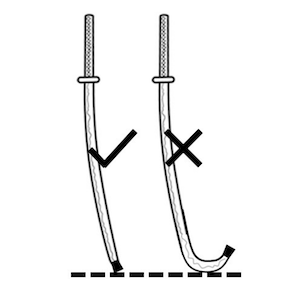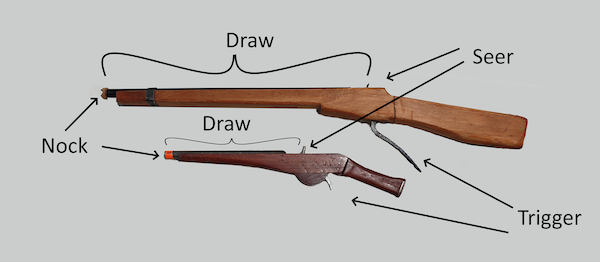Weapons and defensive equipment
Jump to navigation
Jump to search
Swords and daggers
- The bladed weapons (swords and daggers) allowed for fencing combat in Lochac are:
- a sword, which has a blade length of between 45 cm (18 inches) and 122 cm (48 inches) and a grip no longer than 25 cm (10 inches)
- a two-handed sword, which has a blade length of between 76 cm (30 inches) and 122 cm (48 inches) and a grip measuring between 25 cm (10 inches) and 60cm (24 inches). The combined blade and grip length for a two-handed sword must not exceed 152 cm (60 inches).
- a dagger, which has a blade length of between 30 cm (12 inches) and 45 cm (18 inches) and a grip no longer than 25 cm (10 inches).
- Blades must have at most one substantial curve. Blades that are so curved that the tip does not contact the ground when the grip is perpendicular to the ground (i.e., pointed vertically) are not allowed.
- All swords and daggers must have a substantially straight grip.
- Bladed weapons must not have more than one blade.
Blades
Sword and dagger blades used in Lochac can be made of steel or fibreglass. The use of fiberglass blades is listed in Society's Exceptions to Allowed Blades rules.
Steel blades
- Steel blades must be produced by a commercial entity and must meet the flexibility requirements in Safety tests.
- You are not allowed to use sword blades that are similar to a modern fencing foil, epee or sabre, including double-wide epees or "musketeer" blades.
- You can use "flexi-daggers" for Standard fencing. Flexi-daggers are not allowed in Cut and Thrust combat.
- You must not use steel blades with kinks or cracks. Kinked or cracked blades cannot be repaired and must be retired.
- You must not use a blade with a sharp bend or an "S" curve. You can try to re-curve the blade, but a marshal must inspect the blade and agree that it can be used again.
- You must not do anything that might change the temper of the blade or affect its flexibility. This includes grinding, cutting, heating or hammering the blade. Normal combat stresses and blade care do not violate this rule. Exceptions to the rule are:
- You can change the length or width of the tang.
- You can shorten a blade, as long as it still meets the flexibility requirements.
- You can file the end of the tip to make it blunt.
- You can weld a nut or another blunt metal object to the tip to spread impact, as long as you take care to avoid changing the temper of the blade.
Fibreglass blades
- Fibreglass blades must meet the flexibility requirements in Safety tests.
- Fibreglass blades must be made only using fibreglass rod, glue and fibreglass and vinyl tapes. You can use metal to mount the hilt, but it must extend no longer than 10cm along the blade.
- The blade must be wrapped in vinyl duct tape (not cloth or metal-backed). If you use fibreglass strapping tape to make the blade, this must be completely covered by the outer wrapping tape.
Tips
- The tip of a blade must be blunt, with no sharp edges or corners.
- You must cover the tip with a "blunt".
- The blunt can be made of shatter-resistant polymer, rubber or leather.
- The blunt must have a minimum size of 10 mm on any surface that strikes the opponent.
- Polymer and rubber blunts must be at least 3mm thick between the striking surface and the tip or edge of the blade. Leather blunts must be at least 1.6 mm thick.
- You must replace the blunt if it looks like it is bulging or cracking, if there are signs the tip of the blade is breaking, or, in the case of a polymer blunt, if the plastic is changing colour.
- Your blunt must be a different colour to the blade, so that you can tell if the blunt is missing.
- You must tape or glue the blunt to the blade, so that it will not fly off under reasonable combat conditions.
- The tape must not cover the front of the blunt, so that you can tell if the tip of the blade is breaking through.
Other sword parts
- Sword and dagger hilts, handles, pommels and other parts not meant to strike the opponent can be made of metal, wood, leather or a reasonable facsimile.
- The ends of quillons and pommels must be blunt.
Spears
- You can use rubber-headed spears for fencing combat in Lochac. You cannot use steel-headed spears.
- Rubber-headed spears must be made of a flexible rubber head mounted on a rattan haft.
- The spear-head must be purchased from a commercial vendor as a spear tip or spike with a head length of between 10 cm (4 inches) and 51 cm (20 inches). The rubber at the tip must be at least 6 mm (1/4 inch) thick.
- The flexible tip must extend at least 10cm past the end of the haft.
- The spear-head must flex to 90 degrees with hand pressure and must substantially return to its shape within 3 seconds
- The rattan haft must have a diameter between 28.5 mm (1 1/8th inch) and 35 mm (1 3/8th inch):
- The haft must be inserted at least 5cm (2 inches) into the spear-head. The head must be friction-fitted to the haft according to the manufacturer's instructions.
- The head must be taped to the haft with strapping tape, fibreglass tape or duct tape. Contrasting coloured tape must be wrapped around the base of the head, so that the head's absence is readily apparent.
- The haft must have a flat end at the head of the spear with a diameter of at least 12 mm (1/2 inch). The butt end of the haft may be rounded.
- You can put tape on the haft to help prolong its life.
- You can add augmentations or decorations, for example to stop a blade sliding along the haft or to make the haft easier to grip, but they must not weaken the haft or pose a safety risk. You cannot use augmentations that are designed to trap a blade.
- The total length of the spear must be no longer than 275 cm (9 feet).
- Spears may have a spear-head at each end.
Rubber band guns
Guns
- Rubber band guns must look like a period muzzle-loading weapon dated before 1600CE.
- Rubber band guns must be made of sturdy, lightweight materials that will stand up to normal combat. You must make sure all edges and corners are smoothed off and that there are no splinters or cracks.
- There are two categories of rubber band guns, classified by draw length - the distance between the nock and the seer attached to the trigger that the ammunition hooks onto:
- Short-arm rubber band guns have a draw length not exceeding 45cm.
- Long-arm rubber band guns have a draw length exceeding 45cm.
Ammunition
- Rubber band ammunition must be made from commercially available rubber tubing and must not contain any metal parts.
- Ammunition must not use any rigid materials beyond the minimum required to join the ends together. Any hard plastic on the outside of the band should be covered and smoothed by vinyl duct tape or plastic shrink wrapping.
- You are not allowed to fill the rubber bands with sand or liquids.
- You must mark each band to identify the owner.
- You can only use ammunition that has been inspected with the weapon you are using. You are not allowed to collect used ammunition during combat.
- Ammunition must have a draw strength no greater than 13.6 kg (30 pounds). Ammunition must be tested when new and regularly to ensure it complies with this rule.
- The circumference of the ammunition depends on the category of rubber band gun.
- There is no restriction on the circumference of short-arm rubber band gun ammunition
- The circumference of long-arm rubber band gun ammunition must be at least the draw length of the rubber band gun.
- For example, if an rubber band gun has a draw length of 46cm, then the ammunition must have a circumference of at least 46cm.
- As a practical measure, a marshal can flatten a band in half, and use that to measure it against the draw length of the rubber band gun.
- Rubber tubing used to make ammunition must have a minimum diameter of 6 mm while at rest.
Defensive objects
General
- There are two types of defensive object:
- rigid
- non-rigid.
- Rigid defensive objects must be made of sturdy materials that will stand up to the stresses of normal combat. You must make sure that all edges or corners are smoothed and that there are no cracks or splinters.
- Non-rigid objects may be made of cloth, leather and similar yielding materials. They may be weighted with soft material such as rope or rolled cloth. They may not be weighted with any rigid material, nor with materials that are heavy enough to turn the object into a flail or impact weapon.
- Defensive objects that contain both rigid and non-rigid components (such as a flag on a pole) must meet both sets of requirements. You cannot throw these objects (including, for example, a cloak with rigid clasps) at your opponent.
- Objects which even temporarily bind your opponent's weapon to their person or equipment, whether by design or repeated mishap, are not allowed. This may include ropes or whips used in this manner. Ropes or whips used in such a way as to deflect and not bind are allowed.
Non-standard defensive equipment
- Non-standard equipment must be approved by the Fencing Marshal-in-Charge.
- You can put a simulated spike or a similar offensive item on your buckler or shield.
- Offensive items must only be made of cloth, foam, leather, glue and tape and must not contain rigid materials.
- On inspection, the offensive item must provide progressively resistant "give", without allowing contact with any underlying material.
- You must tell your opponent if you are using non-standard equipment. They can decide not to face it and ask you to use something else.
- Non-standard defensive equipment includes, but is not limited to:
- bucklers with a spike or projection more than two inches perpendicular to the main plane of the buckler or the central boss, whichever is applicable. The central boss does not count as a spike or projection.
- bucklers with additions which could reasonably be expected to trap or catch a blade (such as rings or hooks);
- axes;
- Talhoffer "judicial duelling shields" and Talhoffer bucklers;and
- bucklers made out of uncommon materials, such as vegetables, children's toys, etc.
- Fencers should use common sense when applying this definition and be conservative when considering if a defensive item is non-standard, especially when a less-experienced fighter is concerned if an object would be safe to fence against.

